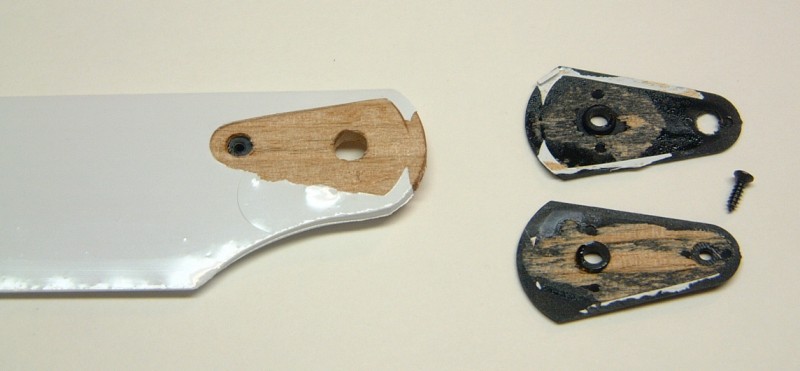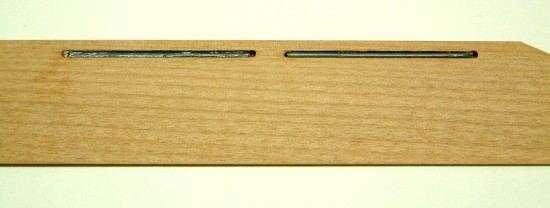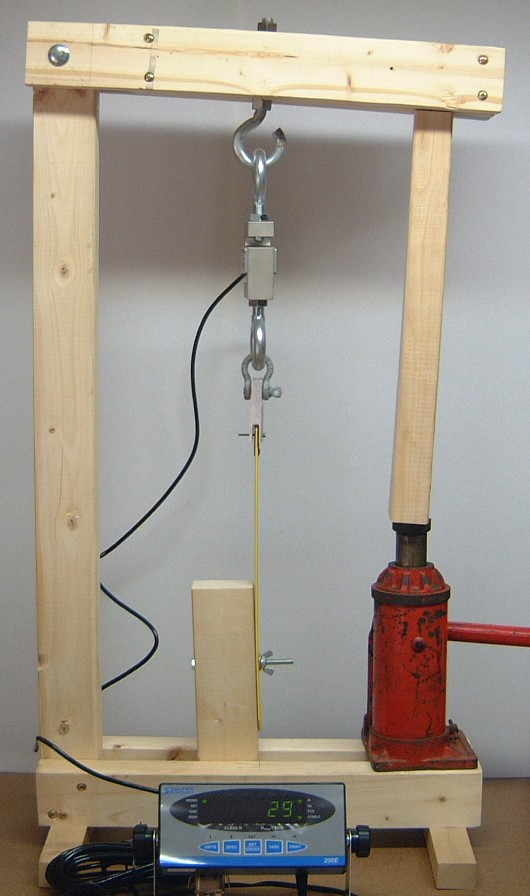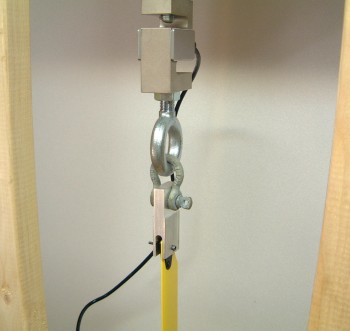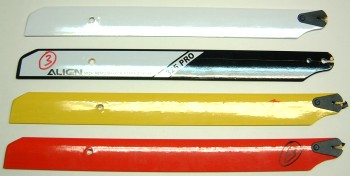|
Tech Pro Blades Support
This page has information supporting our Tech
Pro Blades product.
Specificatons
Tech Pro blades are PVC covered wood blades
and come in five colors and three sizes.
Colors: White, Yellow, Red, Black
and Blue
Sizes: 315mm, 325mm and 335mm
Airfoil: Fully symmetrical
Configuration: Constant cord 31.5mm
wide with a weight range of 16.5 grams to 19.5 grams
Weights: 2 lead strips along outer leading
edge totaling 3.1 grams
Wood Species: Alder
Maximum safe RPM rating is
2400 (See Testing section
below)
Construction
The blade root has both the top and
bottom plastic grips glued on and screwed in place.
Each blade is formed from a single piece of wood and sanded smooth.
Blade root construction
Top side blade tip
Lead weights (3.1 grams) are installed on
the underside (glued in)
Testing
We built a test fixture called the
"Blade Ripper" to determine the force required to pull the blade off the
blade holder bolt.
The jack simply applies force through the blade which is measured by a
digital force gauge (scale). The scale has a
peak hold function which records the maximum force before the blade gives
out.
Blade Testing Results
Our testing has shown that the Tech
Pro blades and the Align Pro blades are about the same strength.
For each, the minimum breaking force was about 212 pounds and maximum was
about 233 pounds.
We can say that the static breaking force is above 200 pounds for both
brands of blades that were tested.
Note: These numbers are based on a total
sample of 20 blades tested.
Blade Force Calculations - Centrifugal Force
The force applied to the blade root (behind
the bolt in flight) can be calculated with the formula below.
Fb = W / G x Ω² x Rcg
Where
Fb is the
force in lbs
W is the weight of the blade in lbs
G is the acceleration of gravity
= 32.2 (ft/sec)²
Ω is the rotor speed = RPM x
2π / 60 radians/sec
Rcg is the distance from the center of the main
shaft to the CG point on the blade.
| Example 1 Given:
325mm blade, 19 grams, RPM = 2400
W
= 19 / 454 = 0.041 lbs
Ω = 2400 x 6.283 /
60 = 251.33 radians/sec
Rcg = 0.64 ft (for a TRex 450 with
plastic head)
Fb
= 0.041 / 32.2 x (251.33)²
x 0.64 = 51.47 lbs
The Force at 2400 RPM is about 52 lbs |
|
Example 2 Given:
325mm blade, 19 grams, RPM = 3100
W
= 19 / 454 = 0.041 lbs
Ω
= 3100 x 6.283 / 60 = 324.62 radians/sec
Rcg = 0.64 ft
(for a TRex 450 with plastic head)
Fb
= 0.041 / 32.2 x (324.62)²
x 0.64 = 85.87 lbs
The Force at 3100 RPM is about 86 lbs |
Summary
The testing was performed on a relatively
small number of blades (20) so there may be smaller minimums and larger
maximums
with respect to the breaking force. There is no practical way to
completely test these blades without damaging them.
Wood is a natural material that is not homogeneous. Defects can be
present which weaken the blade and cause it the break sooner.
The centrifugal force is not the only force on a rotor blade although it
is the major one. These other forces are dynamic and vibratory
in nature and although smaller in magnitude they are considerable since
they have a jack-hammering effect.
A safety margin must be allocated for them.
All wood blades deteriorate (lose strength)
with use. The harder they are worked the weaker they will get.
The centrifugal force is not a linear function
with respect to RPM, it is exponential. If you double the RPM you
will quadruple the force.
These blades are made in a factory overseas.
We have no control of production or quality control. Because of
this, we cannot be held
responsible for any damages or injuries. Use
these blades at your own risk.
Given all of these factors, we recommend
that the maximum RPM ratings on these blades be followed for safety.
Going forward
Our blade testing fixture can handle up to
3000 lbs of force which is limited by the scale. We would like to
test some of the
composite blades out there like the SAB etc. Also, it would be
informative to test some heavily used and abused blades.
Accurate records of the blades history (# of flights etc.) is required
to extract any value from the test data.
We welcome your contributions to this effort.
Copyright © 2006 by Tech Model
Products LLC. • All Rights Reserved |


